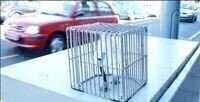Air Monitoring
Pioneering Studies in Roadside Pollution
Apr 08 2008
In order to further understanding of the environmental impact of congested urban traffic networks, the University has set up a permanent research site on its doorstep.
Instruments are routinely collecting measurements of local traffic flow and journey times, meteorology, air and noise pollution around a heavily congested, signalised traffic junction in Headingley, Leeds.
The location was chosen to provide large variations between congestion during peak periods and free-flow times of the day. It is also an ideal site in terms of street architecture, density of businesses and high pedestrian numbers. The department has previously undertaken a range of studies but what makes this one unique is the ability to collate simultaneous measurements from a range of sources, resulting in an
unsurpassed density of data.
“Previously, we have only been able to see peaks and troughs in congestion, now this equipment enables us to quantify it, showing, for example that a journey can take four times longer when traffic is heavy, than in free-flow conditionsâ€, explains Dr James E Tate of the University’s Institute for Transport Studies (ITS).
The location, however, provided specific challenges for road safety, with the planning authority concerned about any potential reduction in sight-lines. ET was able to provide its compact RoadBOX specifically for roadside and hot-spot applications. Designed and manufactured in the UK, each RoadBOX can incorporate up to four MCERTS-approved analysers providing readings for NOx CO or O3 and the BAM1020
PM10 mass monitor. In placement where unobtrusiveness is a key issue, the rugged, vandal-proof boxes are invaluable. Installation takes only a few hours and clients can receive quality data within 24 hours.
In the University’s study, they are being used to measure oxides of nitrogen, ozone and ultra-fine particle number concentration, with three boxes placed around the main junction and another one in a small, quiet street less than 100 metres away.
The data is relayed back to the University via GPRS for analysis on the department’s integrated database. Ultra-fine particle number concentrations and not just PM10 and PM 2.5 are of special interest at the moment as studies to assess their impact on health continue. Results are likely to affect future legislation.
The University’s study also uses an Accuscan 4600 from ET which measures
emissions of CO, CO2, NOx and hydrocarbons emitted from exhaust pipes of up to 4,000 vehicles per. hour as vehicles pass through ultraviolet and infrared sensing beams. The Accuscan unit has been used as part of a low emissions zone scoping study for the City of York as local authorities consider the introduction of their own low emission zones (LEZ) following the launch of London’s LEZ in February 2008.
“Remote sensing devices (RSDs) are the world’s quickest and most convenient form of motor vehicle emissions testing,†explains ET’s operations director, Duncan Mounsor, “The Accuscan 4600 provides a simple diagnostic tool for vehicle emissions pollution problems affecting our major cities.
“We developed the RoadBOX as a special, bespoke unit for ITS as they initially required a small roadside product, much smaller than that we originally supplied.
This requirement forced us to look at the development of the RoadBOX as, within this compact unit, ITS also wanted to measure a variety of compounds. It was initially a challenge to see how we could fit so many analysers and other equipment into the enclosure, but in the end we produced a quality product that met the client’s exact requirements.
“We enjoy working with ITS due to their pioneering approach, interesting
applications and their unparalleled knowledge of how vehicle emissions impact on air quality. ET shares the same pioneering and innovative approach as ITS and we are open-minded and extremely flexible when asked to supply non-standard systems for special applications such as these. As ET becomes more involved with vehicle emission monitoring projects I see some fantastic opportunities ahead of us that we
can both benefit fromâ€.
High-level teams fromthe Department of Transport, Transport for London (TFL) and other local authorities have already visited the installation and are continuing to review its findings. The project, which started on 1st January 2007, has four years of funding, but it is hoped to continue it for 7-10 years, yielding a higher quality long-term
data set. The findings are being made public through conferences, academic papers and journals.
“We found ET very open to creating a bespoke system for us,†commented
Dr Tate, “and their customer support team was excellent. Analysis to date has shown surprisingly large variations in concentrations between stations caused by the prevailing wind direction and speed/street and building geometries, but also by tidal traffic flows.†Researchers interested in accessing data, taking additional measurements, or simply to find out more should contact James Tate (j.e.tate@its.leeds.ac.uk).
Digital Edition
AET 28.3 September 2024
September 2024
Business News - ENVEA announces acquisition of APAQ Group - SICK and Endress+Hauser sign strategic partnership - Efforts to curb gas flaring intensify amid environmental concerns Air Monito...
View all digital editions
Events
WEATHER • CLIMATE • WATER / EARTH OBSERVATIONS / GREEN ECONOMY
Oct 29 2024 St. Petersburg, Russia
Oct 30 2024 Hong Kong
Nov 05 2024 Toronto, Canada
Nov 05 2024 Rimini, Italy
Nov 06 2024 Ho Chi Minh City, Vietnam



















